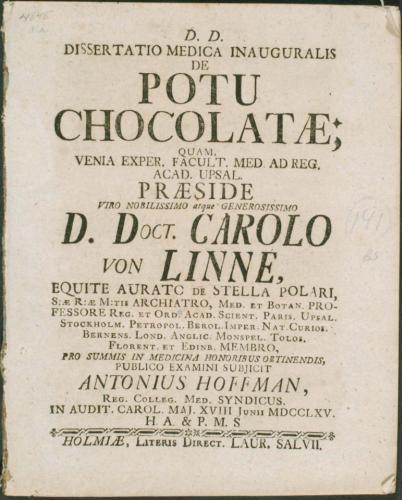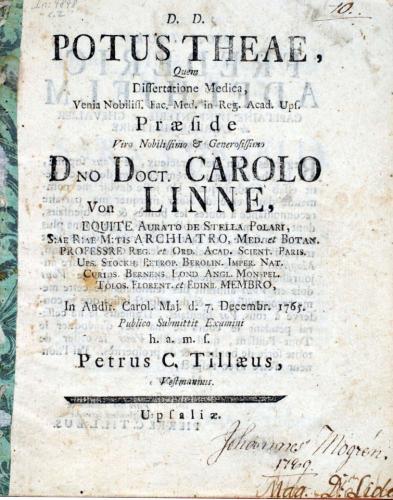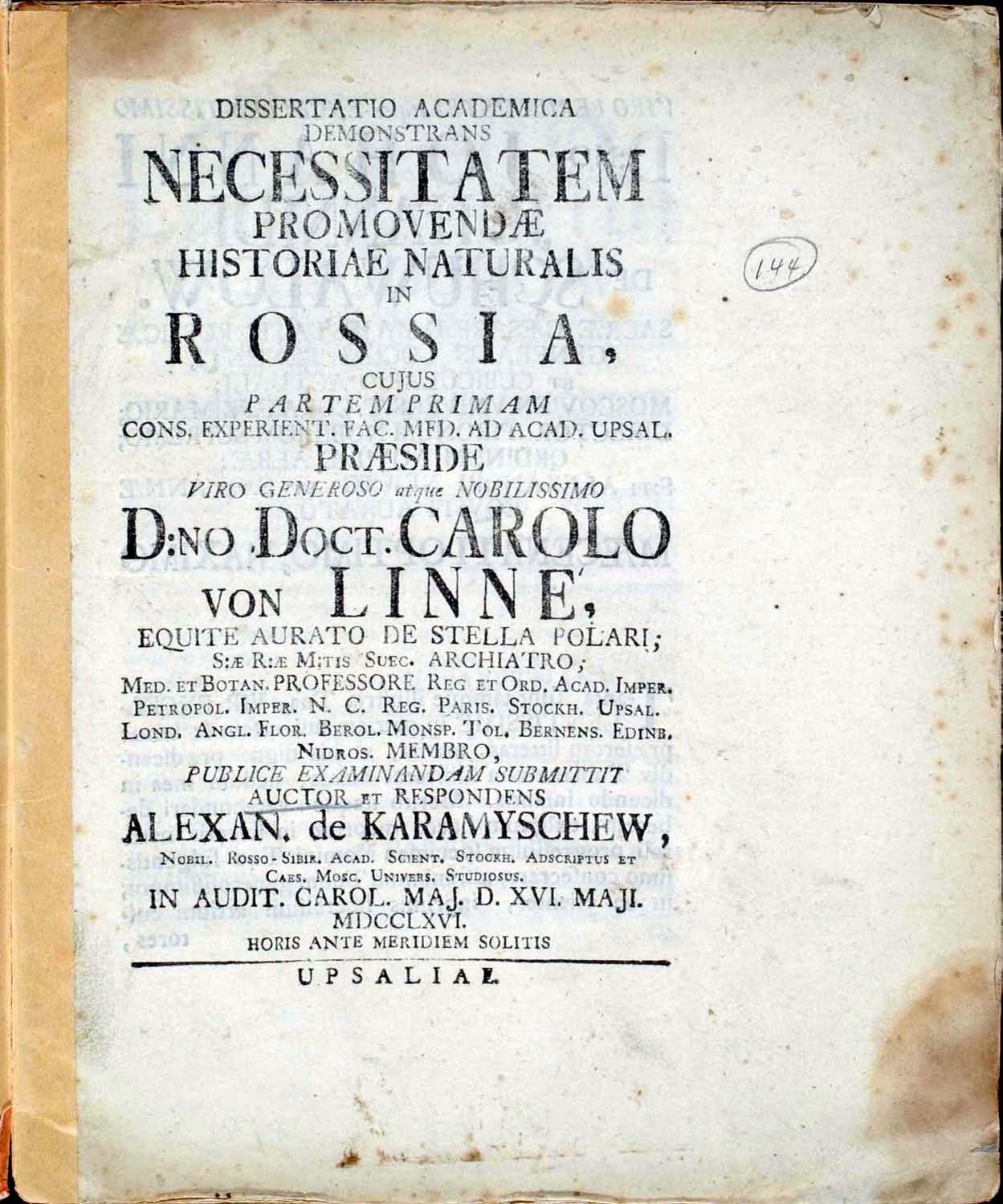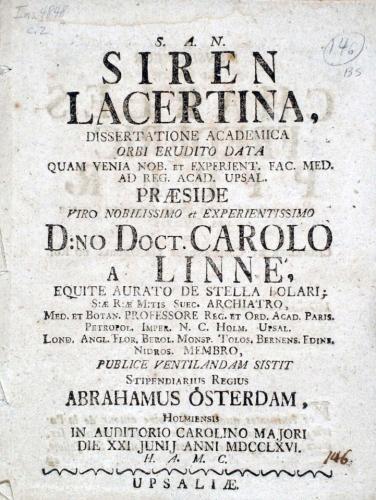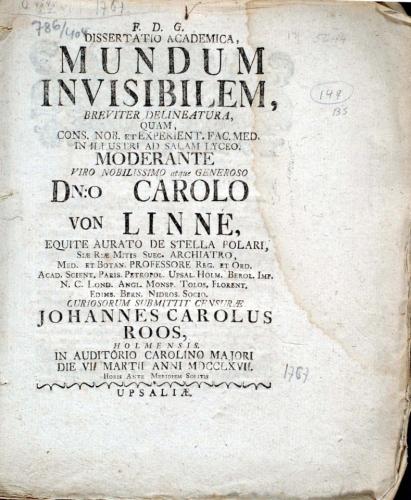Original Linnaean Dissertations
Respondent: Anton Hoffman (1739–1782)
Title: ... de Potu Chocolatae, ...
Date of Defense: 18 June 1765
Paginations: [ii], [1], 2-10
Lidén Title: Potus chocolatae.
Soulsby Title: Pot. choc.
Drake Title: De Potu Chocolate.
Note:
Abstract: A botanico-medical essay on the merits of drinking chocolate, flavored with vanilla. Botanical accounts are given of the cacao tree (Theobroma cacao L.) and of the vanilla orchid (Epidendrum vanilla L. = Vanilla fragrans). The preparation of the chocolate beans and of the beverage by the Spaniards is described. Linnaeus advocated use of the beverage as a pleasant drink and for treatment of hypochrondria and hemorrhoids
Respondent: Pehr Cornelius Tillaeus (1747–1827)
Title: Potus theae, ...
Date of Defense: 7 December 1765
Paginations: [iv], [1], 2-16, 1 plate
Lidén Title: Potus thaeae.
Soulsby Title: Pot. theae
Drake Title: Potus Theae.
Note:
Abstract: The first living plants of tea (Camellia sinensis L.) were brought to Sweden in 1763 by Captain Carl Gustaf Ekeberg (1716-1784), with help from Linnaeus. This was said to be the first successful introduction of the plant into Europe. This dissertation discusses the plant, its preparation and uses, the qualities of tea, and its medicinal use.
Respondent: Peter Strandman (1743–1779)
Title: ... sistens Purgantia Indigena, ...
Date of Defense: 26 February 1766
Paginations: [iv], [1], 2-17, [1]
Lidén Title: Purgantia indigena.
Soulsby Title: Purg. indig.
Drake Title: Purgantia Indigena.
Note:
Abstract: Provides a list of 24 plant species known or reported to have purgative qualities on ingestion. The plants listed were indigenous to or easily cultivated in Sweden.
Respondent: Alexander Von Karamyschew (1744–1791)
Title: ... demonstrans Necessitatem promovendae Historiae Naturalis in Rossia, ...
Date of Defense: { } May 1764
Paginations: [ii], [1], 2-34, [10], 1 plate
Lidén Title: Necessitas promovendae historia naturalis in Rossia.
Soulsby Title: Hist. nat. Rossia
Drake Title: Diss. demonstrans Necessitatem Promovendae Historiae Naturalis in Rossia.
Note: Originally issued in 1764 , this dissertation was not publicly submitted until 1766; Strandell copy of original issue altered in ms. to {16} May {1766}.
Abstract: An essay encouraging the study of natural history in Russia, which mentions important naturalists of that country. Also includes a list of plants native to Russia. First issue printed in 1764, but not publicly submitted intil May 16, 1766.
Respondent: Alexander Von Karamyschew (1744–1791)
Title: ... demonstrans Necessitatem promovendae Historiae Naturalis in Rossia, ...
Date of Defense: 16 May 1766
Paginations: [vi], [1], 2-34, [10], 1 plate
Lidén Title: Necessitas promovendae historia naturalis in Rossia.
Soulsby Title: Hist. nat. Rossia
Drake Title: Diss. demonstrans Necessitatem Promovendae Historiae Naturalis in Rossia.
Note: This is the reissued version for public submission.
Abstract: An essay encouraging the study of natural history in Russia, which mentions important naturalists of that country. Also includes a list of plants native to Russia. First issue printed in 1764, but not publicly submitted intil May 16, 1766.
Respondent: Matvey Ivanovic Aphonin (1739–1810)
Title: ... demonstrans Usum Historiae Naturalis in vita communi, ...
Date of Defense: 17 May 1766
Paginations: [vii], [1], 3-30, [2], 1 plate
Lidén Title: Usus historiae naturalis in vita communi.
Soulsby Title: Usum hist. nat.
Drake Title: Usus Historiae Naturalis in Vita Communi.
Note:
Abstract: An essay on the importance of a knowledge of natural history to greater improvement of agriculture and horticulture, with emphasis on those kinds of plants best suited as food for each kind of domestic animal. The plate includes an illustration of Actaea cimicifuga L. (= Cimicifuga foetida L.), a plant then widely used in eastern Russia as an insecticide (especially against bedbugs).
Respondent: Abraham Österdam (1745–1776)
Title: Siren lacertina ...
Date of Defense: 21 June 1766
Paginations: [iv], [1], 2-15, [1], 1 plate
Lidén Title: Siren lacertina.
Soulsby Title: Siren lacert.
Drake Title: Siren Lacertina.
Note:
Abstract: An account of the two-legged Siren lizard of South Carolina, Sirena lacertina L., sometimes known as the Carolina mud iguana.
Respondent: Johan Gabriel Bergman (1732–1793)
Title: ... de Effectu et Cura Vitiorum Diaeteticorum Generali, ...
Date of Defense: 10 December 1766
Paginations: [ii], [1], 4-24
Lidén Title: Cura generalis.
Soulsby Title: Eff. cura vit.
Drake Title: Effectu & Cura Vitiorum Diaeteticorum Generali.
Note:
Abstract: A medical commentary, in amplification of part one of Linnaeus' pamphlet Clavis medicinae, on cardiovascular diseases. Physiological considerations are reviewed and their importance stressed. The influence of emotional stress is rejected. Arthritis, considered as a vascular disease, is reported as favorably responsive to a diet high in salted meat.
Respondent: Andreas Henricsson Berlin (1746–1773)
Title: ... Usum Muscorum breviter delineatura, ...
Date of Defense: 17 December 1766
Paginations: [iv], [1], 2-14, [2]
Lidén Title: Usus muscorum.
Soulsby Title: Usum musc.
Drake Title: Usus Muscorum.
Note:
Abstract: An historical study of the economic uses of lichens in Sweden (including Lapland)
Respondent: Johan Carl Roos (1745–1828)
Title: ... Mundum invisibilem breviter delineatura, ...
Date of Defense: 6 {7} March 1767
Paginations: [i], [1], 3-23
Lidén Title: Mundus invisibilis.
Soulsby Title: Mund. invis.
Drake Title: Mundus Invisibilis.
Note: Day corrected in manuscript on both copies.
Abstract: A medico-botanical treatise on airborne spores and microorganisms, some of which Linnaeus believed to be responsible for infectious diseases. The thesis is based on the studies of Baron Otto von Münchausen, who corresponded with Linnaeus and whose observations of fungus-caused smut of barley and wheat, along with the dust of fungi, led him to conclude that these are the ova of animalcules, which raised doubts as to whether fungi should be classed with animals or plants.

